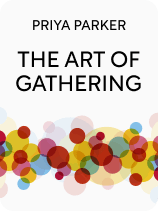

This article is an excerpt from the Shortform book guide to "The Art of Gathering" by Priya Parker. Shortform has the world's best summaries and analyses of books you should be reading.
Like this article? Sign up for a free trial here.
Do you have something to celebrate? How do you plan a party?
In The Art of Gathering, Priya Parker argues that what you do before the gathering is just as important as what you do during the gathering itself. She shares five essential tips: Identify the reason, curate your guest list, select a venue, create directives, and set expectations.
Let’s look at how to plan a party, using Parker’s five tips.
1. Identify the Reason
According to Parker, the first thing you should do when learning how to plan a party is to identify the reason, or “purpose,” for which you’re gathering. You should have one clear, distinct, and specific reason for gathering that’s not defined by the type of gathering you’re having. For example, a bachelorette party is not a reason; “give my bridesmaids a chance to bond with each other before the wedding” is. Why do you need a reason? Parker explains that without one, you might gather in unhelpful ways. This may result in a missed opportunity to do something meaningful. Alternatively, you might gather in ways that are antithetical to your values; this can happen when you follow traditional customs because you find the custom itself significant but not the original reason the custom was developed.
Additionally, Parker argues that when you have one specific reason for gathering, you can use this reason as a guideline by which to evaluate all the decisions you make at the gathering. A specific reason makes decision-making easier because it presents a clear path to follow, whereas a general reason can be ambiguous and open up too many options when you’re trying to decide on something.
For example, in many Western weddings, the bride’s father walks the bride down the aisle. A modern couple might wish not to do this custom since the ritual stems from back when a wedding signified that the bride was now the responsibility of her new husband rather than her father. But if the couple’s parents find meaning in the custom itself, what should the couple do?
If the couple has one clear, specific reason, such as “to celebrate our union as individuals” (as opposed to, say “to celebrate the joining of our families”) then they know what to do: The custom is not about the individual couple but their families, so they won’t do it. But if their reason is something like “celebrate love” and thus doesn’t specify who the focus of the ceremony is, the reason won’t help them make that decision.
To discover your reason, Parker recommends that you repeatedly ask yourself why you’re gathering until you discover an underlying conviction. For example, if you want to have a bachelorette party, ask yourself why that matters.
2. Curate Your Guest List
Once you’ve decided on a reason for gathering, the next step is to curate your guest list. In other words, decide who helps you fulfill your reason—then invite only those people.
Parker explains that despite how it may seem at first glance, limiting your guest list is a compassionate act. If you invite people who don’t support your reason, they may actively sabotage it. But even if they don’t, they’ll still undermine your reason because they’ll inevitably distract you (as the host) with their presence. As a result, you won’t give your full attention to the guests for whom the gathering is designed. In this way, not inviting people who don’t actively support your reason is an act of compassion toward the guests you do invite.
For example, you might travel with your bridesmaids to New Orleans for a bachelorette party so that your bridesmaids, who don’t know each other well, can bond before the wedding. If one bridesmaid has a friend who lives in New Orleans, she may ask if this friend can come to an event you have planned. This friend might sabotage your gathering by dragging your bridesmaid away from the group and having a long conversation with just her. But even if she doesn’t, you’ll be distracted by this friend’s presence; instead of focusing on making sure that your bridesmaids are connecting with each other, you’ll be focused on making sure this friend is having a good time.
(Shortform note: Despite Parker’s contention that limiting your guest list is a compassionate act, some people may grow upset if you either don’t invite them or don’t permit them to bring a guest. So how can you mitigate potential damage? If there’s a risk that a friend will find out that you’ve had an event without them, experts recommend informing them why they’re not invited before that can happen. And if you’re worried that someone might want to bring a plus one, consider creating a written invitation that clearly states that only the recipient is invited.)
When limiting the size of your gathering, Parker recommends that you keep in mind both who and how many people support the purpose. If you want a small, intimate group, limit your gathering to six to 12 people. If you want to foster intimacy while still allowing for diverse perspectives, you can have up to 15 people. For a more animated, party-like vibe, invite 30 people. And if you want a big gathering, a group of 150 people feels large but still connected.
(Shortform note: Keep in mind that the bigger your gathering, the bigger the budget you’ll need for it. So even if you want a livelier vibe, you may be unable to provide one due to financial constraints. This is particularly true if you’re serving food or drinks, as this cost is directly proportional to the number of attendees. Experts suggest that a corporate event that serves breakfast, lunch, and dinner should budget about $150 per person—which would amount to $900 for a small gathering of six but nearly $20,000 for a group of 150.)
3. Select an Appropriate Venue
Once you know how many people are coming to your gathering, select an appropriate venue. Parker explains that an appropriate venue has three important qualities. First, it will immerse your guests in the reason for the gathering and thus enhance their experience. Second, it will encourage the conduct you desire (and discourage conduct you don’t want), as people are primed to behave differently depending on the environment. Third, it will encourage unexpected behavior in your guests—in this case, a slightly unexpected venue will help.
For example, if you work at a foundation that supports marine life, try holding an important meeting not in a conference room but in an aquarium exhibit. By surrounding your participants with marine life, you’ll enhance their experience. You’ll also encourage them to make (perhaps unexpected) decisions that help sea life and discourage the more business-oriented decisions that they’re used to making in the conference room.
4. Create Directives
The fourth pre-gathering step, according to Parker, is to create directives, which she calls “pop-up rules.” In other words, give specific instructions about how you’d like your guests to behave during the event—such as that they should all bring a particular type of dish—and clearly communicate them to your guests.
Parker recommends creating directives for two reasons. First, clear directives make diverse gatherings more comfortable. Many hosts expect their guests to behave according to certain defined protocols. However, this expectation often backfires in an increasingly multicultural world. If your guest list is diverse, they will have different (and potentially clashing) cultural expectations for what is appropriate; for example, a Japanese person will expect guests to help them clean up after a house party, while an American might find this practice insulting. Clear directives remove a lot of potential friction and pave the way for a smoother gathering.
Second, Parker argues that clear directives encourage engagement. For example, people are often glued to their cell phones—even in situations when checking their phone is generally considered rude. But if you temporarily ban cell phones during your gathering, the short-term nature of this directive will make it seem more like a rule of a game. As a result, your guests will find pleasure in ignoring their cell phones rather than feeling restricted—and thus be more engaged within your gathering.
Parker advises keeping two things in mind when creating directives. First, your directives should be one-time-only. This doesn’t mean that you can’t use the same directive (like no cell phones) for multiple events; rather, it means that the fact that one gathering is a certain way doesn’t mean that all subsequent gatherings will be that way. By making these directives one-time-only, you can experiment with different kinds of directives and create very specific moods at specific gatherings.
Second, while it’s better to explicitly communicate your directives to guests in advance, your directives can be spur-of-the-moment if necessary. For example, Parker once held a retreat for a Thai company. The retreat was designed to foster the consultants’ relationship with each other; however, the cultural expectation that the consultants were available to their clients at all times caused several consultants to repeatedly arrive late to several sessions. Parker created a spur-of-the-moment directive that any late consultant had to do push-ups; this directive encouraged people to arrive on time.
5. Set Expectations
The fifth pre-gathering step, according to Parker, is to set expectations. While most hosts assume that the gathering begins when everybody arrives, Parker argues that in reality, the start of your gathering is whenever you tell a guest about it. So during the lead-up to your gathering, you should set expectations with your guests so that they have a clear idea of what will happen.
Parker contends that setting clear expectations during the lead-up to your guests’ arrival is essential for two reasons. First, setting expectations will help your guests get into the right mood. As a result, they’ll arrive at the gathering feeling more open to fully participating in the experience. Second, setting expectations prevents guests from feeling cheated. It reduces the possibility that your guests will feel disappointed because their own (incorrect) expectations for the gathering were unfulfilled.
Parker recommends two strategies for setting clear expectations. First, name your gathering. The right name will communicate to your guests both what they should be doing during the gathering and how the gathering relates to their roles. For example, is your business gathering a workshop or a seminar? A workshop implies that your guests will need to be active and possibly brainstorm ideas during the gathering, while a seminar suggests that your guests will be more passive and perhaps take notes while listening to a lecture.
(Shortform note: Setting clear expectations is also important in other social situations—notably when dating. When asking someone out, experts recommend that you explicitly name the occasion: Say that you’d like to take them on a “date” instead of merely suggesting that you hang out. By doing so, you establish the right mood pre-date, give them sufficient time to prepare, and communicate what behavior is and isn’t appropriate during the occasion. You also prevent any awkwardness or disappointment that may arise from unfulfilled expectations if your date mistakenly believes that you’re hanging out as just friends.)
Second, ask people to do things that encourage them to arrive at the gathering in the right mindset. For example, if you want to hold a year-end business meeting to reflect on your accomplishments, you might ask people to think of someone they want to celebrate (if the mood is celebratory) or ask them to name some challenges (if the mood is more reflective).
(Shortform note: When setting clear expectations with others, don’t forget to manage your own expectations, too! Be realistic when asking your guests to do pre-gathering tasks: Asking people to think of someone they want to celebrate is reasonable; asking them to write a report with two days’ notice is probably not. Keeping your expectations in check reduces the likelihood that you’ll be disappointed at the gathering’s outcome and ensures that you don’t damage your relationships with your guests by making unreasonable demands.)

———End of Preview———
Like what you just read? Read the rest of the world's best book summary and analysis of Priya Parker's "The Art of Gathering" at Shortform.
Here's what you'll find in our full The Art of Gathering summary:
- How to make pre-planned gatherings more meaningful and engaging
- What to do before, during, and after any type of gathering
- Why the host should never relax during their event






